It could appear intimidating to put in a stair runner your self, but it surely’s so darn simple that we’ve achieved it twice! Thrice for those who rely demonstrating it on live TV (extra on that later). Simply observe the steps in our tutorial beneath, together with our trick for ensuring your rug is the right measurement for the venture.


Including a rug or runner to your stairs isn’t only a trendy decor selection that may add shade, persona, or sample. It’s additionally a security characteristic! We discover that including a stair runner cuts down on slips, falls, and even makes it simpler for our canine to traverse them. Additionally they soak up sound, that means your much less prone to hear your child clomping up and down the steps. So we extremely suggest including one for those who’ve received younger kids, pets, and even simply clumsy adults round.
DIY Stair Runner Earlier than & Afters
The primary time we put in a stair runner, it was to exchange a dingy carpet runner that got here with the home. You may see within the pictures beneath that we not solely livened up the steps with a bold striped rug, we additionally modernized the steps by portray the risers, trim, & balusters white and marking the wooden handrails darkish.
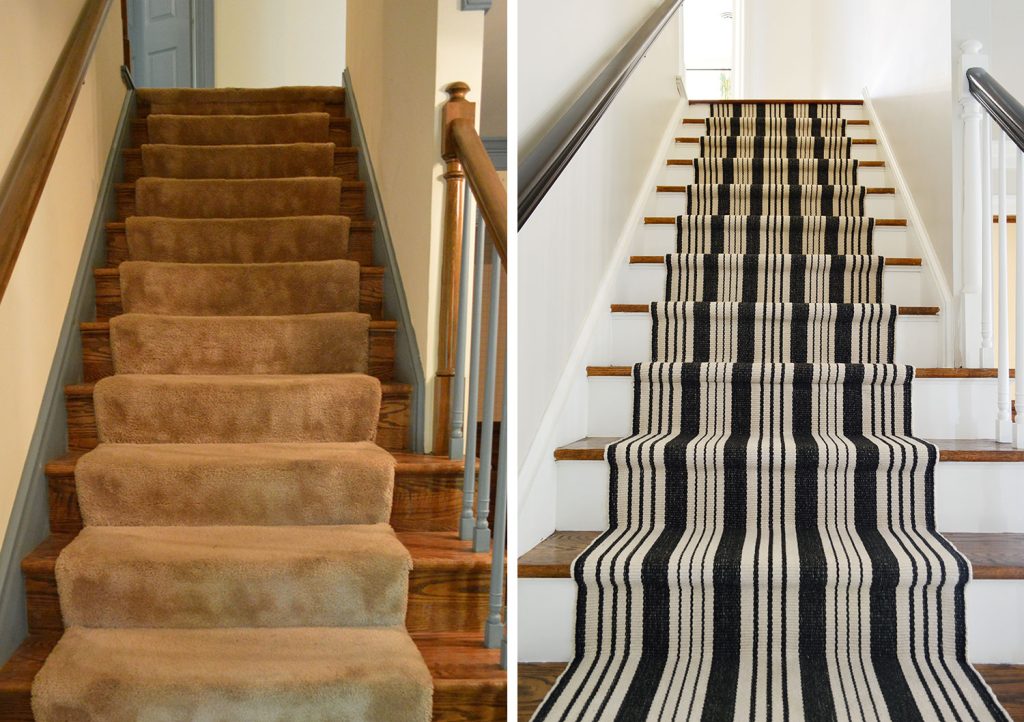

For our second set up, right here in our present house, we used a beachy sisal runner as an alternative. We additionally painted the treads a cautious grey to brighten them up.


The “third” stair runner we added was for a DIY segment we taped for The Rachael Ray Show. We solely shot about 3 staples on digital camera, however we prepped the small pretend staircase backstage. It’s too dangerous we didn’t get to do a complete staircase. That runner is cute!


Total, you have got numerous methods you possibly can customise this venture to fit your fashion and your stairs. So let’s dive into the tutorial!
Instruments, Supplies, & Value
Listed below are the provides and instruments you must have helpful to put in your personal stair runner:
This doesn’t need to be an costly venture both. Our first runner set up price lower than $300! It principally depends upon the runner you select and the way a lot you want.
Steps To Set up A Stair Runner
Our venture in complete took us about 20 hours, however that additionally included eradicating the previous runner and portray the risers and railings. The precise stair runner set up solely took about 4 hours, though could rely upon the size of your stairs. We’ll go into every step in additional element, however right here’s an summary of the method:
- Take away your previous runner (if wanted)
- Measure
- Choose a runner
- Paint or stain your stairs (non-compulsory)
- Mark your placement
- Lower the rug pad
- Put together your staples
- Begin on the high
- Join two runners (if wanted)
- End the underside edge
Step 1: Take away your previous runner
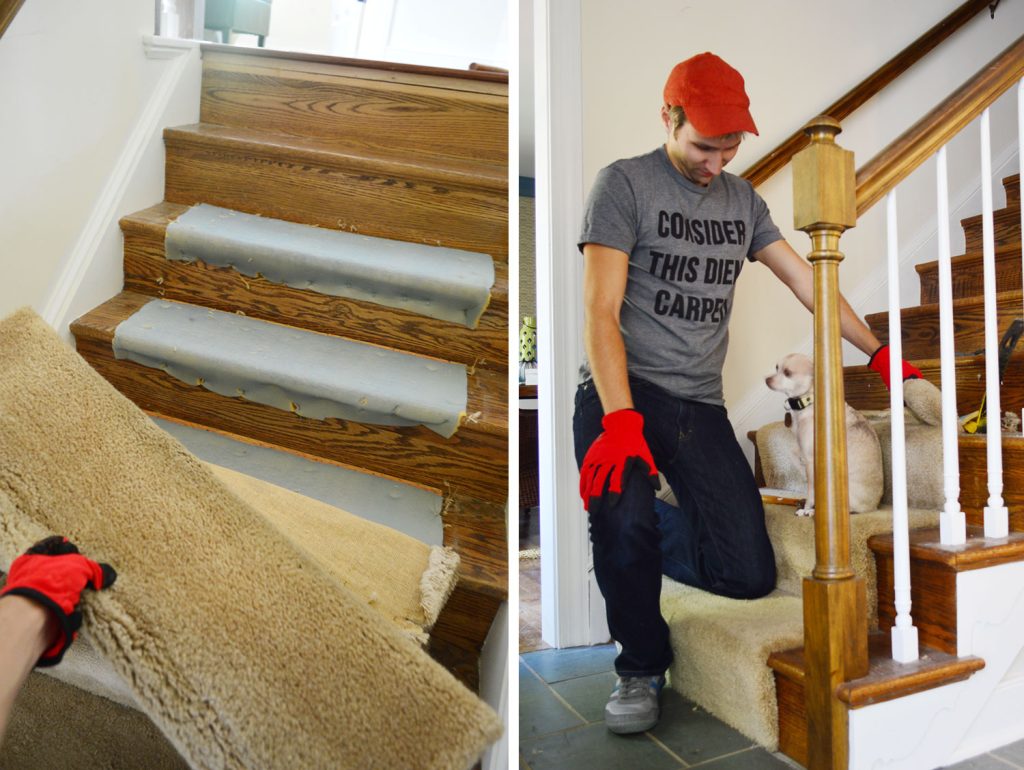

This step solely applies if in case you have an current rug, runner, or carpet in your stairs that should go. This course of could take time – particularly getting the entire previous stapes up! We counted almost 600 staples in our previous carpet. We’ve a separate stair runner removal tutorial for this, together with what instruments you’ll need to assist get that previous carpeting off.
Step 2: Measure
Earlier than shopping for your runner, you’ll must measure how a lot you’ll want. As with every rug, the essential measurements are size and width. Figuring out this will even allow you to decide if you should buy a inventory measurement or must order one thing customized.
Measuring runner size
We propose utilizing a string or versatile measuring tape to find out the size of 1 step. This implies riser + tread, together with across the entrance bullnose edge. Multiply this measurement by the variety of steps you have got, after which add 10-15% further. Having an excessive amount of materials is less complicated to cope with than not having sufficient!
Measuring runner width


Most stair runners don’t go wall-to-wall. As a substitute, they depart about 2-3″ uncovered on both facet (see above). This quantity is private choice, and it could be dictated by inventory sizes. Measure the width of your narrowest stair, and subtract 4-6″ to get your runner width. Simply be conscious that many staircases “flare” on the backside, so be sure no matter width you select will match and look good from high to backside.
Step 3: Choose a runner
Nearly any carpet or rug could be changed into DIY stair runner. Nonetheless, we propose selecting one thing that might be sturdy and simple to wash, particularly in case your stairway will get numerous foot site visitors. Indoor/out of doors rugs and pure fiber rugs like wool or cotton are nice for these causes. We additionally counsel one thing low pile, since they’re simpler to maintain clear. We’ve used each inventory and customized runners for our stairs.
Utilizing a inventory runner
For our striped runner, we used a rug from Annie Selke (previously Sprint & Albert) as a result of they’re recognized for his or her sturdiness. Additionally they have tons of patterns and colours, and most types are available in quite a lot of sizes. We used two 2.5′ x 8′ Birmingham runners, however they now additionally promote a 20-foot model and as a customizable size. After 7 years of use, we are able to vouch that it held up nice (other than some fading from solar) and felt fairly comfortable underfoot!
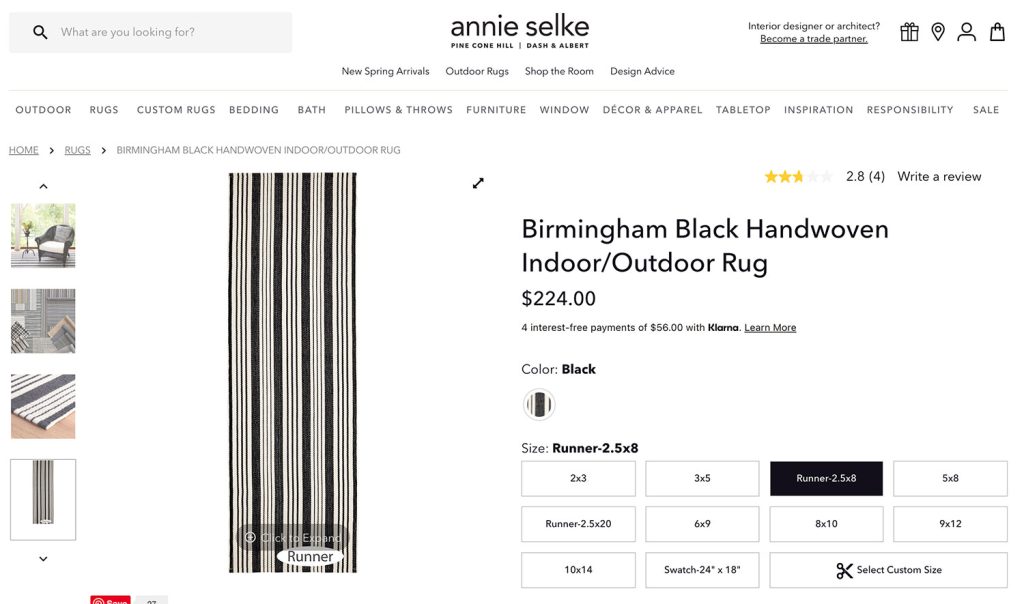

Inventory runners are usually cheaper, however they might require extra ingenuity to suit exactly to your house. Don’t fear – we’ll present you ways!
Utilizing a customized runner
For our sisal runner, we ordered a customized out of doors rug from Sisal Rugs. This gave us nice management over the precise look – we picked the colour, border materials, border shade, measurement, and many others – and solely price us barely about $100 greater than 2 Annie Selke rugs would’ve on the time.


We’ve been equally proud of each varieties of rugs we’ve used – inventory vs customized, cotton vs sisal, daring vs impartial – so you must be ok with selecting no matter is greatest for you.
Step 4: Paint or Stain Your Stairs
In case your stair makeover plans embody any portray, staining, or different doubtlessly messy updates: do them now! You don’t need to have to fret about dripping a brand new rug later!
Earlier than we added our striped runner, we stained the handrail a darker shade and painted the balusters, trim, and risers white. These had been considerably time-consuming duties, so they’re nice to deal with whilst you’re ready in your rug order to reach.


Earlier than including our sisal runner, we determined to color the stair treads a heat grey to cowl up some discoloration within the stain. We used this Porch & Floor Enamel in Requisite Grey by Sherwin-Williams. It didn’t require a primer and has held up nice!
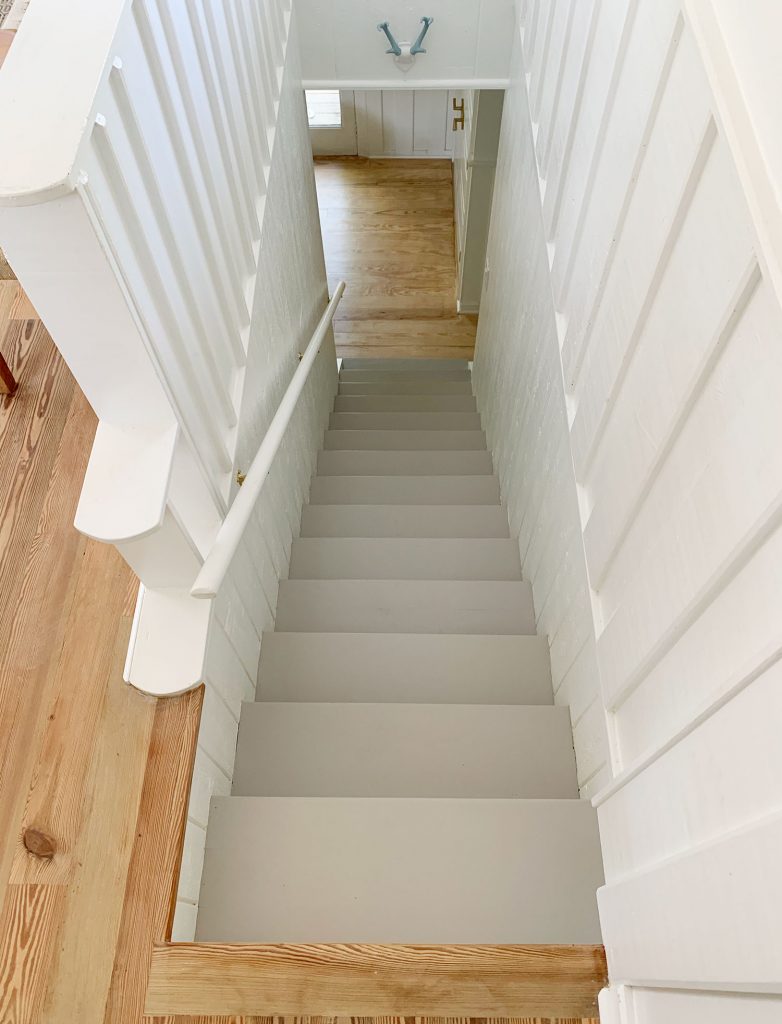

This additionally is a good time to do some other repairs to the steps – like if in case you have a unfastened or squeaky tread, or want to repair any close by molding.
Step 5: Mark Your Placement
When you’re prepared to put in your runner, begin by marking its placement on each step. This may assist be sure it stays straight and doesn’t drift to the facet as you put in it. We used a measuring tape and painter’s tape to mark the sides alongside every tread, which you’ll be able to see beneath.


Alternatively, you possibly can verify your placement with a ruler or measuring tape as you go. We simply discovered it sooner to tape down guides in the beginning of the venture.
Step 6: Lower The Rug Pad
You’ll desire a rug pad below your runner to (1) present extra cushion and (2) hold the runner in place. If you happen to don’t need further cushion, you should use carpet tape as an alternative. We’ve used each a felt rug pad and a rubber rug pad with equal success. Simply be sure whichever you select has a non-slip design. Each are offered in a number of sizes, together with runner lengths, and don’t must be very thick (we use 1/8″ depth).
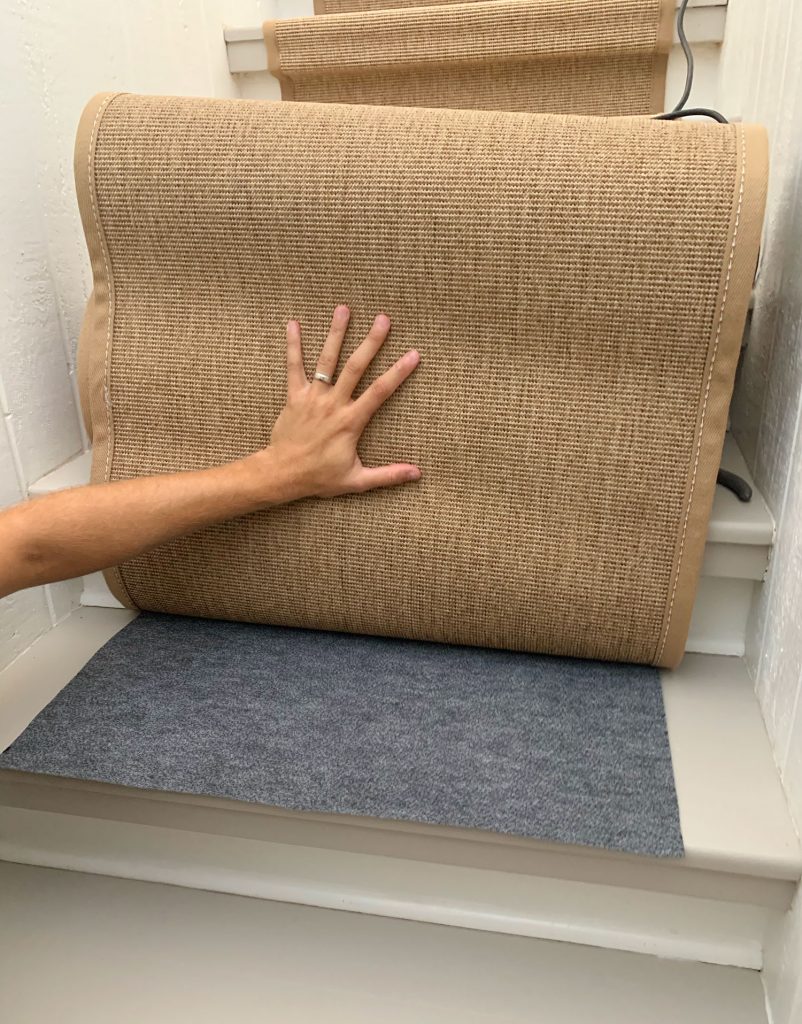

We favor to make use of the rug pad ONLY on the tread floor (not the vertical riser). This protects cash and in addition prevents pointless bulk towards the riser. Nevertheless it does require a while upfront to chop the rug pad into strips. Fortunately they often lower simply with family scissors. We depart it lengthy sufficient to wrap across the entrance nostril of the stair.


We depart sufficient overhang so the rug pad can wrap across the bullnose of every step, as you possibly can inform above.
Step 7: Put together Your Staples
Right here comes the bizarre step, however we promise it’s price it! After some trial and error, we discovered an electric staple gun designed for upholstery initiatives to be the simplest strategy to safe a stair runner. A hand-powered staple gun was too light-duty. We wanted one thing with extra oomph!
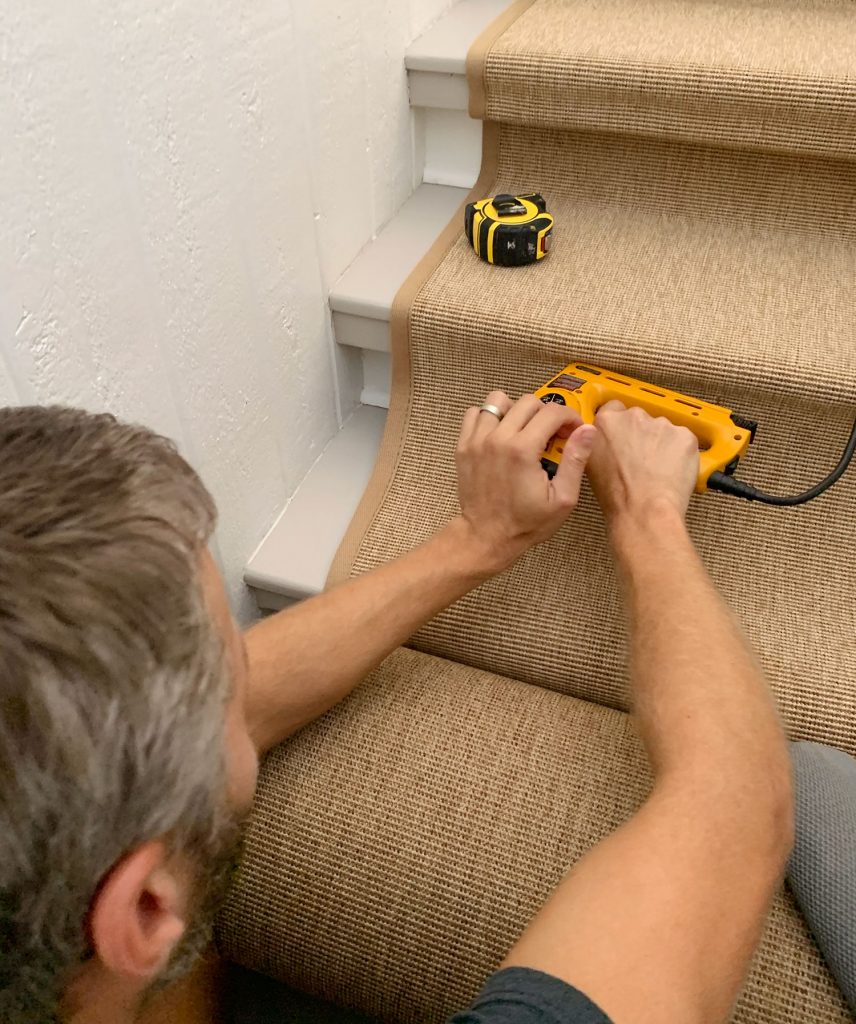

The downside to this strategy is that your staples could also be seen UNLESS you’re taking the time to paint them first. I do know it sounds bizarre, however belief us. It really works!


For our sisal runner, we used a gold Sharpie to roughly shade a strip of staples earlier than loading them into the stapler. For our black and white runner, we did the identical factor with a black Sharpie.
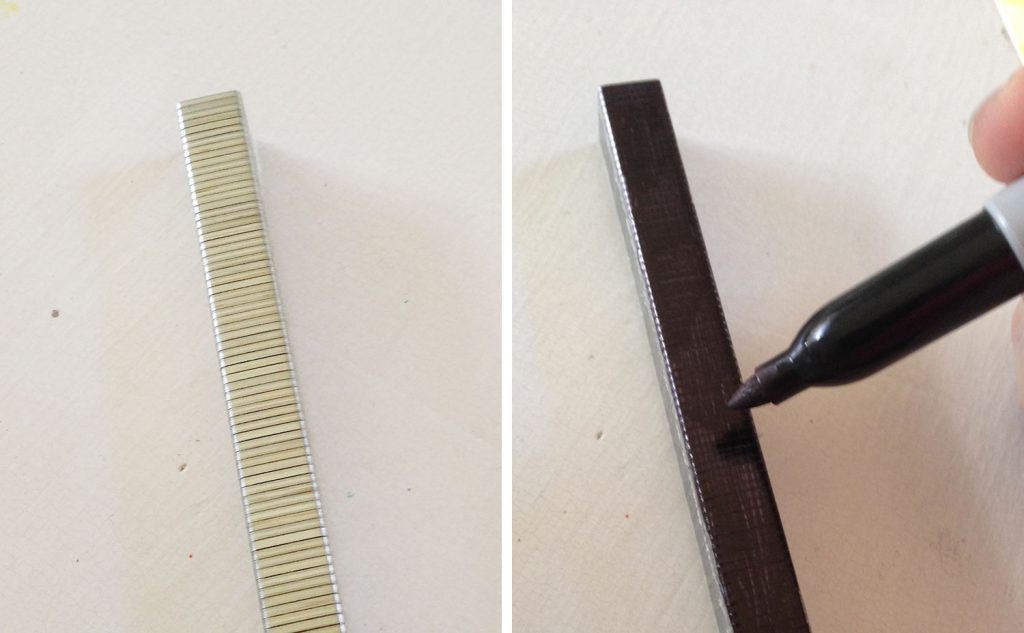

Matching the precise shade of your rug isn’t essential as a result of the principle good thing about this strategy is that it removes the SHINE of the staples. The staples had been principally seen after they catch the sunshine, so the Sharpie ink dulls them sufficient that they camouflage into the sample of the rug.
Coloring one large strip of staples earlier than you set them within the stapler is way sooner than doing it individually after they’re caught into your rug. However you possibly can take a look at it on a couple of stapled staples first if you wish to decide what shade provides the very best disguise.
Step 8: Begin At The High
Start stapling your runner below the lip on the high of your staircase. Take your time to place your runner exactly – protecting the highest edge flush, and your edges aligned together with your tape markings. Use the electric staple gun to safe it at every edge and about 4-5 locations within the center. Your rug’s sample could decide the place greatest to put your staples so they’re as hidden as doable. You can too return and add extra staples later whether it is sagging anyplace. The essential half now’s to simply get it hooked up.


With the runner stapled alongside the highest, pull it tight towards the riser and staple alongside the underside into the RISER, not the TREAD. At no level throughout this course of will you have to nail into the treads. This manner you don’t have to fret about naked ft ever feeling chilly steel.
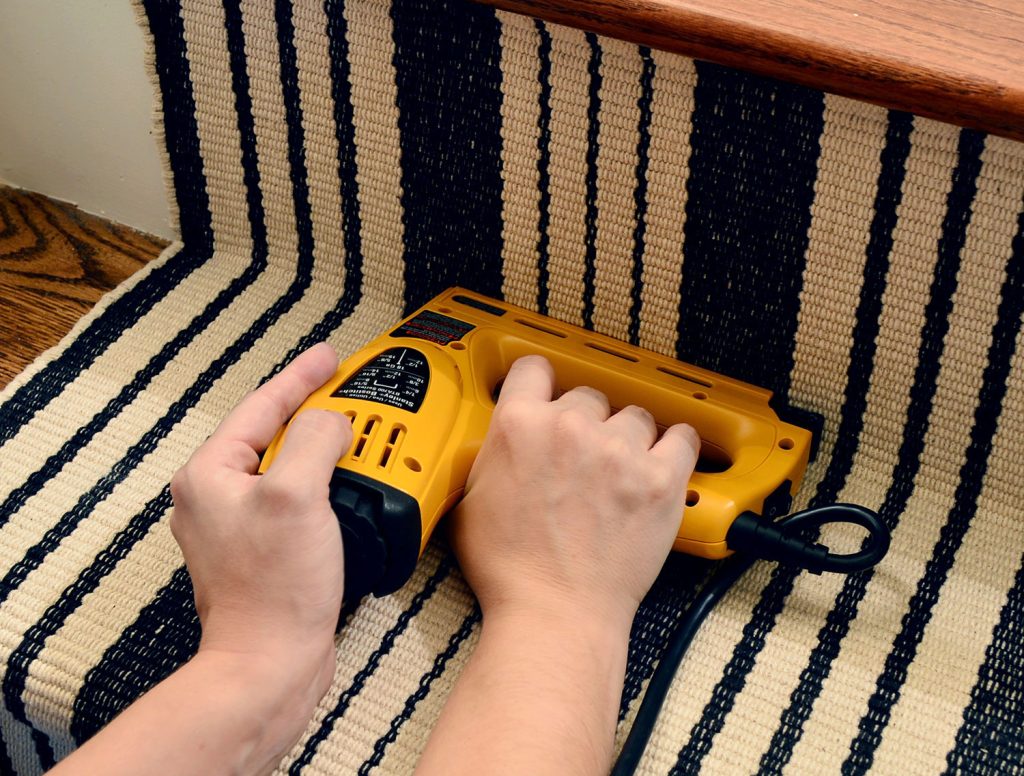

Subsequent, pull the runner tight alongside the tread and repeat this course of, beginning with one other row of staples below the lip of the subsequent tread.
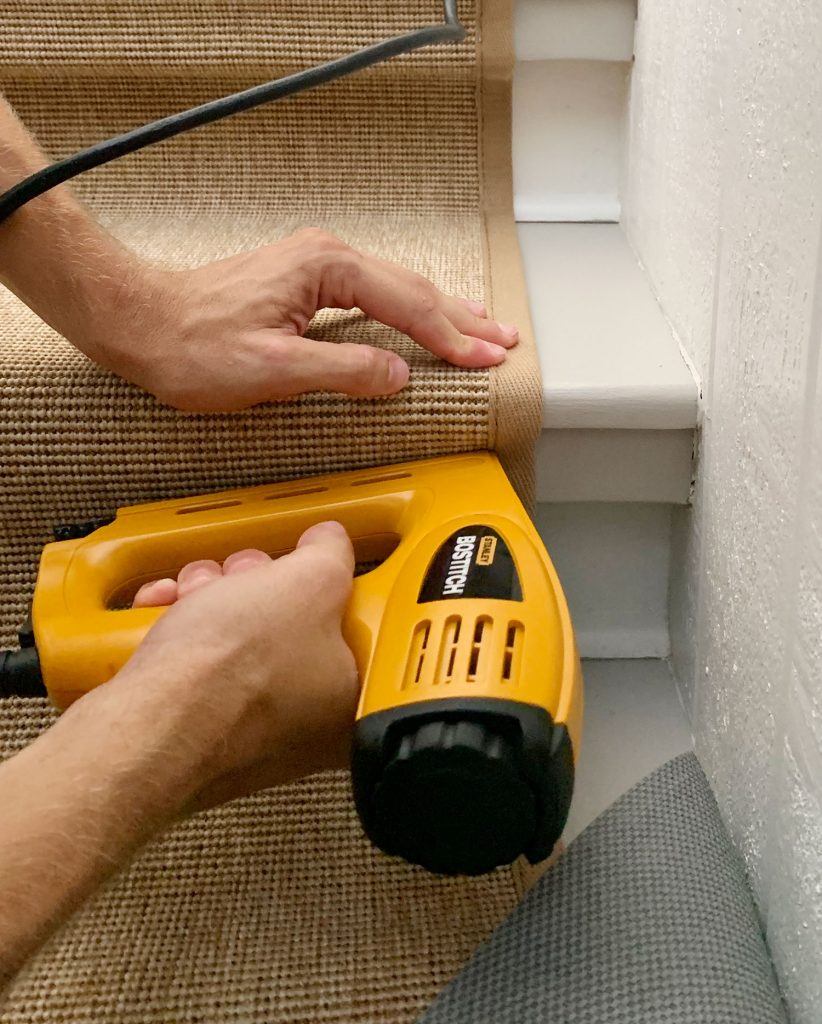

Use your judgment as to the place & what number of staples are wanted to carry your runner tight to the steps. With our sisal runner (above) we had two “lips” below every tread, so we needed to do two rows of staples alongside the highest of every step. Additionally, don’t fret if you have to take away a misfired staple on occasion. Simply hold some needlenose pliers helpful.
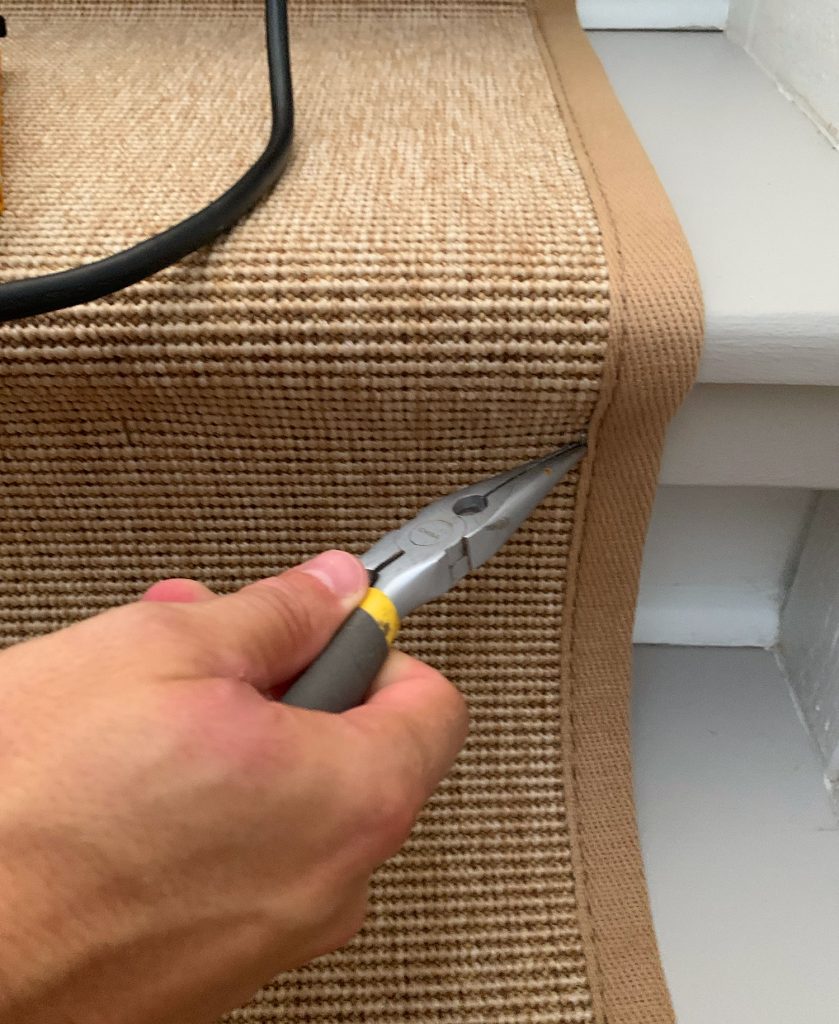

Proceed this course of, working down your stairs in direction of the underside. Simply bear in mind to maintain pulling your runner tight and ensure it’s not drifting to at least one facet as you go. Oh, and don’t overlook to place down your rug pad strips as you go.
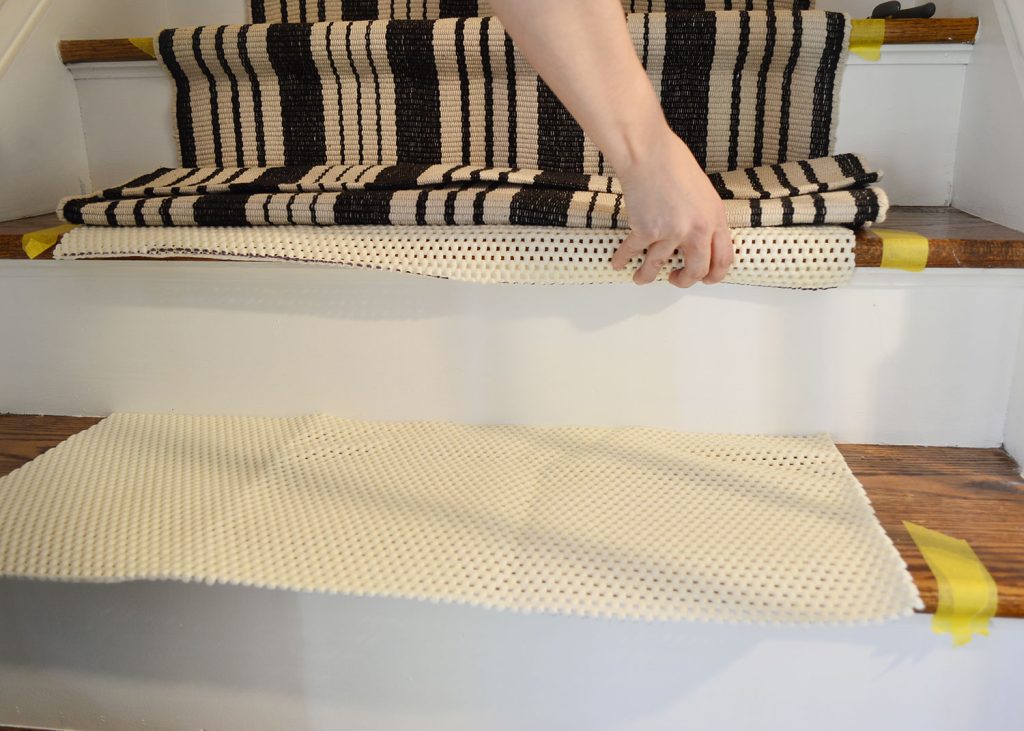

Additionally, we discover the electrical staple gun works greatest while you apply stress to the again of it as you fireplace. This helps the staples sink deeper into the swood.
Step 9: Join Two Runners
If one runner gained’t attain the underside of your stairs, it’s simple to seamlessly join two separate runners. One of the simplest ways to do that is to cover the transition below the lip of a tread. Use scissors to chop off any further materials out of your first runner in order that it terminates below the lip.
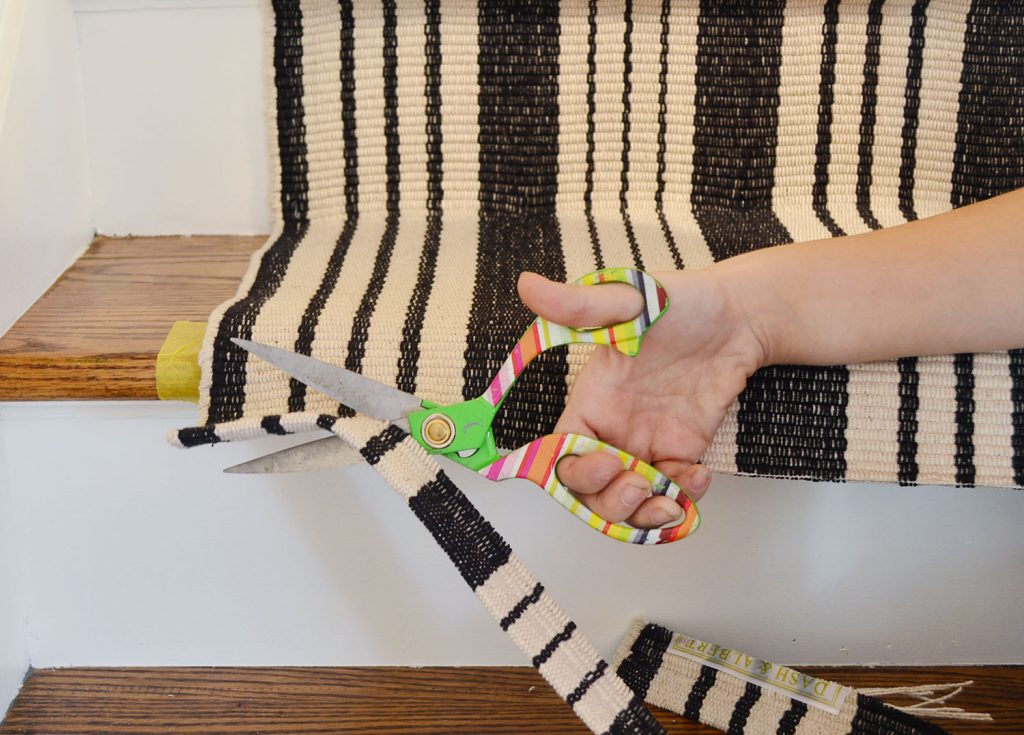

Staple that lower finish proper below the bullnose fringe of the tread, simply as you have got been doing.


Then connect the second runner below the lip, identical to you probably did with the primary runner on the high of your stairs. From there, you possibly can proceed down your stairs with the second runner. Here’s a completed image of our stairs. Can you discover the spot the place one runner ends and the opposite begins?
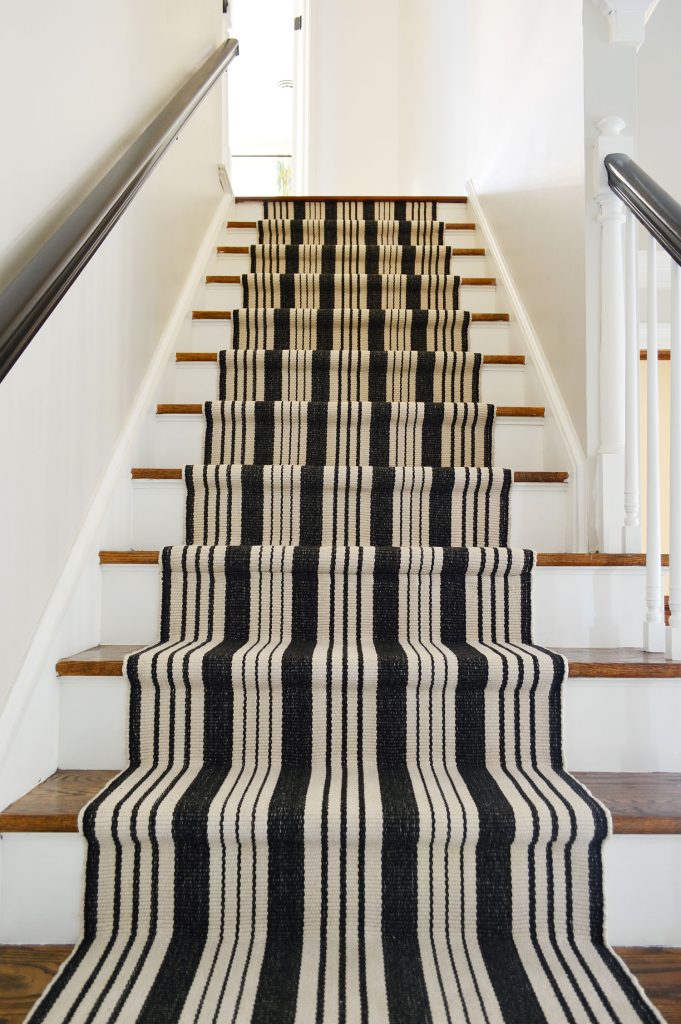

You may kinda see it there about 3 steps up. The transition isn’t 100% undetectable, but it surely’s so refined you solely actually discover it for those who’re searching for it.
Step 9: End The Backside Edge
When you get to the underside, use scissors to chop off any extra materials – leaving about an additional inch of fabric. Fold this further bit again below the runner and staple it into the underside of the rise. This fold provides a cleaner, even edge on the underside (since some runners will fray barely when lower).
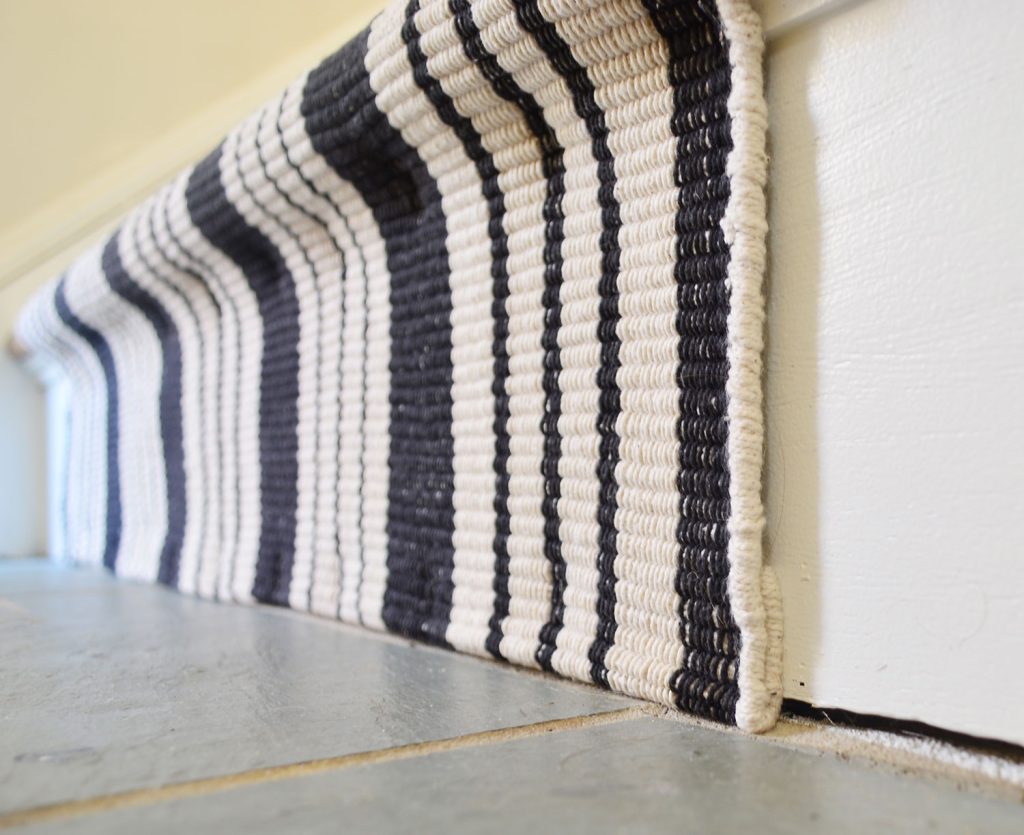

And identical to that, you’ve completed your stair runner set up!


You may learn extra specifics about installing our sisal stair runner, and see extra earlier than & after footage of that house.
Stair Runner FAQs
Listed below are solutions to different questions we incessantly get about putting in a stair runner.
How properly do stair runners maintain up?


Our stair runners have held up very properly, even with busy children & pets in the home. Like all rug or carpet, they require common vacuuming and the occasional stain removing. However so long as you select a sturdy materials like an indoor/out of doors polypropylene rug or a pure fiber rug, you must have little hassle. We lived with our striper runner for over 7 years earlier than transferring, and we solely skilled gentle fading on the backside (the place it received numerous daylight) and a few small, however barely noticeable, fraying on the nostril of a step or two.
Do stair runners injury the steps?
If you set up a stair runner, you’ll put small staple holes in your stair risers. A stair runner additionally could trigger your paint or stain end to fade inconsistently, as a result of steps being partially lined. Nonetheless, each of those could be remedied with wooden putty and a contemporary coat of paint or stain.
What are the benefits of a stair runner?
Along with bettering the look of your stairs, you’re additionally making your steps safer and quieter while you set up a stair runner. Rugs soak up sound and lower down on the noise of loud footsteps. Additionally they are much less slick than wooden steps, which makes slips and falls much less frequent.
How do stair runners keep in place?
Stair runners keep in place because of a mixture of staples and rug pads. The staples maintain the rug tight to every riser, serving to it type to the form of the staircase. Rug pads below the tread hold it from transferring underfoot. Alternatively, you should use stair carpet rods to carry the rug tight to the riser.
What are alternate options to a stair runner?
In our historic seaside house, we didn’t need to set up a everlasting stair runner. We used two alternate options to assist our canine not slip on the steps. On our entrance steps, we used non-slip sisal treads held in place with carpet tape. On our again stairs, we used clear non-slip treads for a virtually invisible look.
*This put up accommodates affiliate hyperlinks, so we could earn a small fee while you make a purchase order by hyperlinks on our web site at no further price to you.





